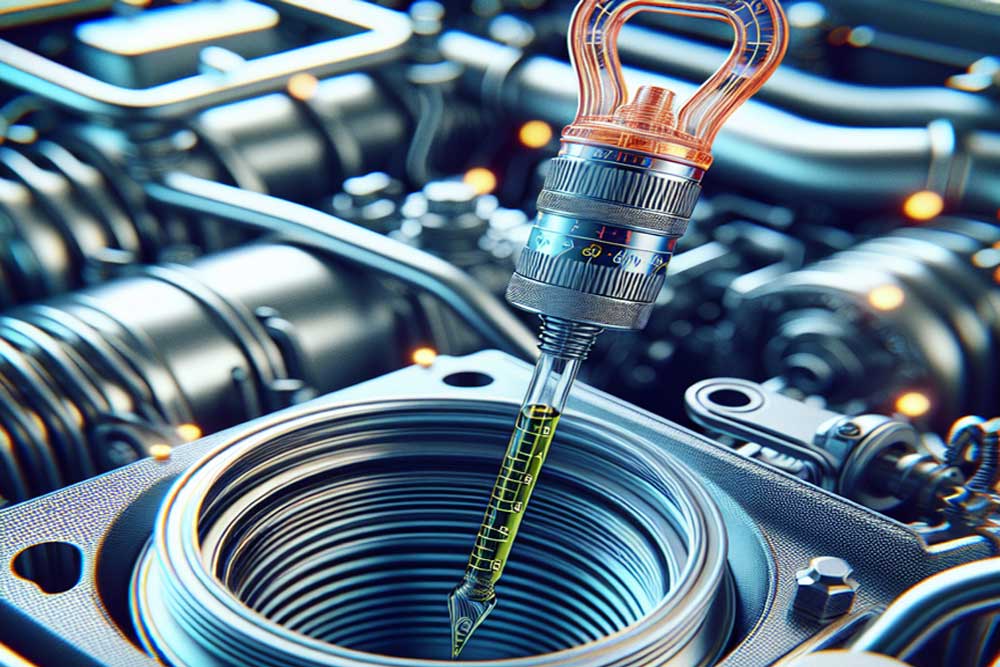Understanding your car’s oil dipstick is essential for maintaining engine health. This simple tool helps you monitor oil levels, ensuring your engine runs smoothly.
Regular checks can prevent costly repairs and extend your vehicle’s life. Many car owners overlook this crucial maintenance step, risking engine damage.
The dipstick is easy to use and provides valuable insights into your engine’s condition. Knowing how to read it can save you time and money.
In this guide, we’ll explore the function of the car oil dipstick. You’ll learn how to check and interpret oil levels accurately.
By the end, you’ll be equipped to keep your engine in top shape.
What Is a Car Oil Dipstick?
A car oil dipstick is a slender metal rod used to gauge the engine oil level. Located in the engine bay, it features a brightly-colored handle for easy visibility. This tool is essential for monitoring and maintaining proper oil levels in your vehicle.
Knowing the parts of a dipstick helps in understanding its function:
- Handle: For pulling the dipstick out of the engine.
- Shaft: The long, thin metal portion that enters the engine.
- Tip: The end with markings to indicate oil levels.
The dipstick plays a vital role in car maintenance. It gives you quick access to check your engine oil, letting you ensure everything is as it should be. This easy-to-use tool allows car owners to perform routine checks without professional help.
Why Checking Oil Level Matters
Regularly checking the oil level is crucial for maintaining engine health. Engine oil lubricates moving parts, reducing friction and wear. Without enough oil, these parts can overheat and sustain damage.
Monitoring the oil level also aids in identifying potential problems. For example, frequent low oil levels may indicate leaks or other mechanical issues. Recognizing these early can save on costly repairs and extend engine life.
Benefits of checking oil level:
- Ensures efficient engine performance.
- Helps prevent overheating or damage.
- Identifies potential oil leaks.
Ignoring low oil levels can lead to severe engine malfunctions. These issues diminish performance and might void warranties. By maintaining proper oil levels, car owners can enhance their vehicle’s efficiency and longevity.
Where to Find the Oil Dipstick in Your Car
Locating the oil dipstick in your car is simple. Typically, it is found in the engine bay, marked by a bright handle. The handle is often yellow or orange for easy identification.
The exact position can vary depending on your car model. Generally, it will be near the front or side of the engine. Always ensure your car is turned off and on a flat surface before attempting to check.
Common locations for oil dipstick:
- Near the front of the engine
- On the engine’s side
- Marked with a yellow or orange handle
Consulting the owner’s manual can provide specific details. This ensures you are pulling the correct dipstick and not confusing it with other engine components.
How to Check Car Engine Oil: Step-by-Step Guide
Checking your car’s engine oil is a straightforward process. You only need a few minutes and a clean rag. This guide will walk you through the steps.
First, ensure your car is on a level surface and the engine is cool. A warm engine can give inaccurate readings and may pose safety risks.
Next, open the hood of your vehicle. Locate the oil dipstick, which should be easily identifiable by its bright handle. Ensure it is the correct dipstick by referring to your car manual if needed.
Once found, pull the dipstick out slowly. Wipe it clean with a rag or paper towel. This removes the oil that may have splashed onto it during operation.
Insert the clean dipstick back into its tube fully. Ensure it is fully seated to get an accurate reading. Then, remove it once again carefully without touching any engine parts.
Check the oil level marked on the dipstick. Look for the two markings that indicate the minimum and maximum levels. Your oil should fall between these two marks.
Steps to Check Oil:
- Park on level ground and cool the engine.
- Locate and remove the dipstick.
- Wipe it clean and reinsert it completely.
- Remove again to read oil level.
Inspecting your oil regularly helps maintain optimal engine performance. Regular checks can also alert you to leaks or other issues early. Always replace the dipstick once done to prevent contamination.
How to Read Oil Level on Dipstick
Reading the oil level on a dipstick may seem tricky at first. But once you understand the markings, it becomes simple. The key is to focus on the indicators at the end of the dipstick.
Most dipsticks have two markings: the minimum and maximum levels. These marks show where your oil level should ideally be. Your oil should always register between these lines to ensure sufficient lubrication.
If the oil level is below the minimum mark, your engine needs more oil. Running an engine with low oil can cause severe damage due to increased friction. Add the recommended oil type as specified in your car’s manual.
In contrast, if the oil exceeds the maximum level, it may require draining. Overfilled oil can lead to pressure buildup and leaks. It’s crucial to address this promptly to protect your engine.
Key points for checking the dipstick:
- Look for min/max markings.
- Ensure oil is between these marks.
- Adjust oil level if necessary.
Accurate readings require good lighting, ensuring you see the oil clearly against the stick. Regular practice will make you efficient at interpreting oil dipstick readings.
Understanding Oil Dipstick Markings: Where Should Oil Be?
Oil dipstick markings are straightforward yet crucial for engine health. They provide a visual cue of your vehicle’s oil level, guiding necessary actions.
Typically, these markings appear as two lines or dots. Some dipsticks may have a cross-hatched area between the markers. Your oil level should ideally sit within this zone to indicate proper levels.
Running low on oil could lead to engine wear. Conversely, too much oil isn’t healthy either. This can cause aeration, reducing lubrication efficiency, and hurting engine performance.
To ensure optimal oil levels:
- Look between the minimum and maximum markers.
- Check when the car is cool, on a level surface.
- Adjust levels promptly if out of the specified range.
Understanding these markings can prevent costly repairs. Regular checks and timely adjustments maintain smooth engine operations.
What Oil Color and Consistency Tell You
Oil’s color and consistency offer insights into its condition. Fresh oil usually appears light brown or golden. As oil ages or becomes contaminated, it darkens.
Pay attention to these signs when checking oil:
- Golden and smooth: Oil is in good condition.
- Dark and thick: Possible contamination; consider an oil change.
- Milky appearance: Could signal coolant leak; professional inspection needed.
Besides color, check for grit. Gritty oil needs changing as it can harm engine parts. Consistent checks can help maintain optimal engine health and performance.
Common Mistakes When Checking Oil Dipstick
Checking the oil dipstick may seem simple, yet common mistakes occur. Many forget to let the engine cool before checking, which affects accuracy.
Another frequent error is not fully reinserting the dipstick after wiping it clean. This leads to incorrect readings.
Be mindful of these common errors:
- Skipping engine cooldown before checking.
- Not wiping the dipstick clean.
- Failing to fully reinsert the dipstick.
- Checking on an uneven surface.
Avoiding these pitfalls ensures an accurate oil level reading, helping maintain engine health. Simple diligence can prevent significant issues down the road.
How Often Should You Check Engine Oil?
Regularly checking your engine oil is key to maintaining a healthy engine. It ensures the oil remains at the correct level for optimal performance.
A good rule of thumb is to check the oil level once a month. Additionally, inspect before long journeys to avoid unexpected problems.
Consider these pointers:
- Monthly oil level checks.
- Always check before long drives.
- Adjust frequency if your car has high mileage or oil consumption.
Sticking to this routine helps in spotting issues early, preventing costly repairs.
Troubleshooting: Low or High Oil Dipstick Level
Encountering a low or high oil dipstick level can be alarming. Each scenario requires attention to ensure your engine runs smoothly.
If the dipstick indicates a low oil level, it may mean your engine is consuming excess oil or there’s a potential leak. Conversely, an overfilled oil level can cause increased pressure, leading to engine damage.
Consider these steps for troubleshooting:
- For low levels: Inspect for leaks and top up oil.
- For high levels: Drain excess oil and check for fuel contamination.
- Monitor oil levels consistently to detect recurring issues.
Monitoring and addressing these levels promptly protects your engine’s health.
Electronic Oil Sensors vs. Manual Dipstick Checks
Modern vehicles often come equipped with electronic oil sensors. These sensors offer convenient and real-time oil level monitoring. However, they should not replace regular manual checks.
Manual dipstick checks provide more comprehensive insights. They allow you to observe oil color, consistency, and potential contaminants firsthand.
Benefits of manual checks:
- Validate sensor accuracy.
- Assess oil condition visually.
- Detect issues early through direct observation.
Key Takeaways for Car Owners
Understanding how to check and read your car oil dipstick is essential for vehicle maintenance. Regular checks can prevent engine issues and save you money.
Remember these points:
- Regularly check oil, at least once a month.
- Use the dipstick to verify oil level and condition.
- Manual checks supplement electronic sensors effectively.
Conclusion
Maintaining your car’s oil dipstick is a fundamental aspect of vehicle care that shouldn’t be overlooked. By regularly checking your oil levels, understanding how to read the dipstick, and recognizing the signs of oil condition, you can significantly enhance your engine’s performance and longevity. Whether you’re checking for low oil levels or ensuring you don’t overfill, these simple practices can prevent costly repairs and extend the life of your vehicle.
Remember, a well-lubricated engine runs smoother, operates more efficiently, and is less prone to breakdowns. Make it a routine to inspect your engine oil at least once a month and before long journeys. Keeping your car’s oil dipstick in mind could save you time, money, and the stress of unexpected mechanical issues. Stay proactive with your vehicle maintenance, and you’ll ensure a smoother ride for years to come.











